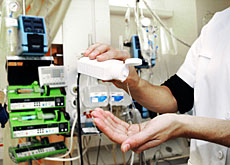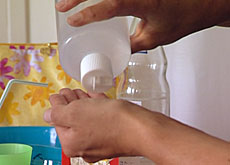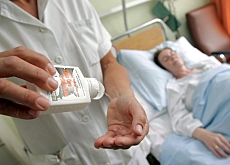Hospital hygiene blitz cuts infections by 25%

Hospital infections linked to poor hand hygiene have fallen by around a quarter following the launch of nationwide campaign earlier this year.
Those behind the hygiene offensive in more than 100 hospitals and clinics say more frequent hand washing by medical staff has resulted in health cost savings of around SFr60 million ($48 million).
“This success shows us what can be achieved by working together in a targeted manner,” said Hugo Sax, who is leading the campaign. “We now need to ensure that [regular hand washing] become a natural instinct. The keyword is continuity.”
The initiative was launched in January by the Federal Health Office and Swiss-Noso, a medical body dedicated to improving hospital hygiene.
It followed alarming data showing that hospital staff were not complying with rules to wash hands after every contact with a patient.
The campaign, which recommends regular hand washing with an alcohol-based antiseptic, is based on a model developed by Geneva University Hospital that has also been adopted by the World Health Organization.
Prior to the campaign, it was estimated that hospital infections affected around 70,000 Swiss patients, generating additional annual health costs of SFr240 million.
Death toll
According to health office figures, between 1,000 and 2,000 patients die from these infections every year.
Patients with weak immune systems and those in intensive care are particularly at risk from infection, as are the elderly and those suffering from illnesses such as diabetes, cancer and chronic lung problems.
“Hand hygiene represents the first step towards reducing hospital infections,” said Sax, a doctor at Geneva University Hospital’s department of infection prevention and control.
“It concerns every member of staff and each contact with a patient. The application of more specific measures in fields such as intravenous catheters and surgical interventions should lead to further progress. The reduction potential is estimated at 30 per cent.”
Nurses were found to have made the most progress in improving hand hygiene practices, with doctors lagging slightly behind.
Sax said this was symptomatic of a global phenomenon whereby doctors had a tendency to underestimate the cumulative effect of “banal” preventive measures. But he noted that Swiss doctors had obtained better scores than colleagues in other countries.
swissinfo, Adam Beaumont
The Swiss hand hygiene model was developed by Didier Pittet, head of the infection control programme at Geneva University Hospital.
It recommends that hospital staff use an alcohol-based hand rub, which has proved to be more effective than soap and water.
Introduction of the hand hygiene strategy saw the level of infections at the hospital fall by half.
The model has since been exported to hospitals in Europe, the United States, Canada, China, Japan and Australia.
A study by Swiss-Noso found that 7.2% of hospital patients contracted an infection. This figure rose to one in four for intensive-care patients.
According to the WHO, 25% of patients in developing countries pick up infections.

In compliance with the JTI standards
More: SWI swissinfo.ch certified by the Journalism Trust Initiative


You can find an overview of ongoing debates with our journalists here. Please join us!
If you want to start a conversation about a topic raised in this article or want to report factual errors, email us at english@swissinfo.ch.